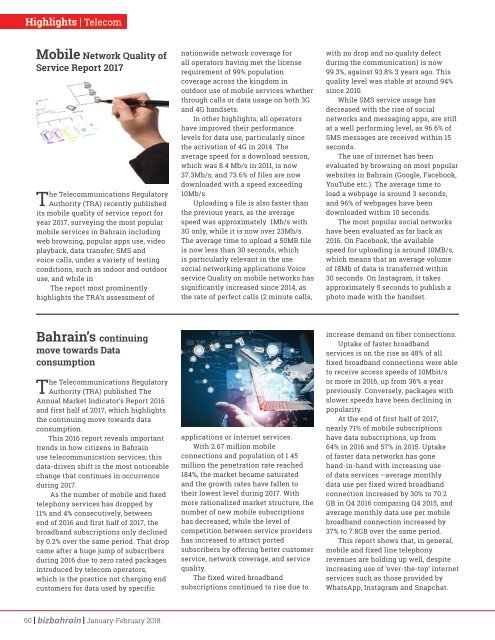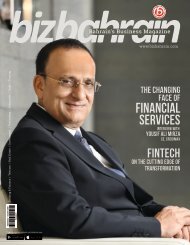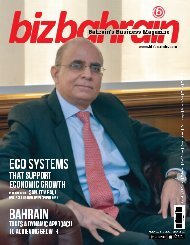You also want an ePaper? Increase the reach of your titles
YUMPU automatically turns print PDFs into web optimized ePapers that Google loves.
Highlights | Telecom<br />
Mobile Network Quality of<br />
Service Report 2017<br />
The Telecommunications Regulatory<br />
Authority (TRA) recently published<br />
its mobile quality of service report for<br />
year 2017, surveying the most popular<br />
mobile services in Bahrain including<br />
web browsing, popular apps use, video<br />
playback, data transfer, SMS and<br />
voice calls, under a variety of testing<br />
conditions, such as indoor and outdoor<br />
use, and while in<br />
The report most prominently<br />
highlights the TRA’s assessment of<br />
nationwide network coverage for<br />
all operators having met the license<br />
requirement of 99% population<br />
coverage across the kingdom in<br />
outdoor use of mobile services whether<br />
through calls or data usage on both 3G<br />
and 4G handsets.<br />
In other highlights, all operators<br />
have improved their performance<br />
levels for data use, particularly since<br />
the activation of 4G in 2014. The<br />
average speed for a download session,<br />
which was 8.4 Mb/s in 2011, is now<br />
37.3Mb/s, and 73.6% of files are now<br />
downloaded with a speed exceeding<br />
10Mb/s.<br />
Uploading a file is also faster than<br />
the previous years, as the average<br />
speed was approximately 1Mb/s with<br />
3G only, while it is now over 23Mb/s.<br />
The average time to upload a 50MB file<br />
is now less than 30 seconds, which<br />
is particularly relevant in the use<br />
social networking applications.Voice<br />
service Quality on mobile networks has<br />
significantly increased since 2014, as<br />
the rate of perfect calls (2 minute calls,<br />
with no drop and no quality defect<br />
during the communication) is now<br />
99.3%, against 93.8% 3 years ago. This<br />
quality level was stable at around 94%<br />
since 2010.<br />
While SMS service usage has<br />
decreased with the rise of social<br />
networks and messaging apps, are still<br />
at a well performing level, as 96.6% of<br />
SMS messages are received within 15<br />
seconds.<br />
The use of internet has been<br />
evaluated by browsing on most popular<br />
websites in Bahrain (Google, Facebook,<br />
YouTube etc.). The average time to<br />
load a webpage is around 3 seconds,<br />
and 96% of webpages have been<br />
downloaded within 10 seconds.<br />
The most popular social networks<br />
have been evaluated as far back as<br />
2016. On Facebook, the available<br />
speed for uploading is around 10MB/s,<br />
which means that an average volume<br />
of 18Mb of data is transferred within<br />
30 seconds. On Instagram, it takes<br />
approximately 5 seconds to publish a<br />
photo made with the handset.<br />
Bahrain’s continuing<br />
move towards Data<br />
consumption<br />
The Telecommunications Regulatory<br />
Authority (TRA) published The<br />
Annual Market Indicator’s Report 2016<br />
and first half of 2017, which highlights<br />
the continuing move towards data<br />
consumption.<br />
This 2016 report reveals important<br />
trends in how citizens in Bahrain<br />
use telecommunication services; this<br />
data-driven shift is the most noticeable<br />
change that continues in occurrence<br />
during 2017.<br />
As the number of mobile and fixed<br />
telephony services has dropped by<br />
11% and 4% consecutively, between<br />
end of 2016 and first half of 2017, the<br />
broadband subscriptions only declined<br />
by 0.2% over the same period. That drop<br />
came after a huge jump of subscribers<br />
during 2016 due to zero rated packages<br />
introduced by telecom operators,<br />
which is the practice not charging end<br />
customers for data used by specific<br />
applications or internet services.<br />
With 2.67 million mobile<br />
connections and population of 1.45<br />
million the penetration rate reached<br />
184%, the market became saturated<br />
and the growth rates have fallen to<br />
their lowest level during 2017. With<br />
more rationalized market structure, the<br />
number of new mobile subscriptions<br />
has decreased, while the level of<br />
competition between service providers<br />
has increased to attract ported<br />
subscribers by offering better customer<br />
service, network coverage, and service<br />
quality.<br />
The fixed wired broadband<br />
subscriptions continued to rise due to<br />
increase demand on fiber connections.<br />
Uptake of faster broadband<br />
services is on the rise as 48% of all<br />
fixed broadband connections were able<br />
to receive access speeds of 10Mbit/s<br />
or more in 2016, up from 36% a year<br />
previously. Conversely, packages with<br />
slower speeds have been declining in<br />
popularity.<br />
At the end of first half of 2017,<br />
nearly 71% of mobile subscriptions<br />
have data subscriptions, up from<br />
64% in 2016 and 57% in 2015. Uptake<br />
of faster data networks has gone<br />
hand-in-hand with increasing use<br />
of data services –average monthly<br />
data use per fixed wired broadband<br />
connection increased by 30% to 70.2<br />
GB in Q4 2016 comparing Q4 2015, and<br />
average monthly data use per mobile<br />
broadband connection increased by<br />
37% to 7.8GB over the same period.<br />
This report shows that, in general,<br />
mobile and fixed line telephony<br />
revenues are holding up well, despite<br />
increasing use of ‘over-the-top’ internet<br />
services such as those provided by<br />
WhatsApp, Instagram and Snapchat.<br />
60 January-February <strong>2018</strong>

















